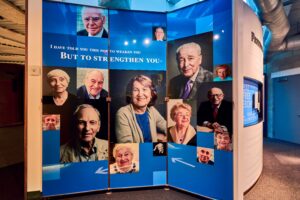Virtual field trips educate young people on the history and lessons of the Holocaust and genocide, as well as broader topics of social justice and civic engagement. Pre and post-visit activity aid educators in extending students’ learning and fostering meaningful learning experiences.
Group size: Limited only by your technology capacity.
Times Offered: Asynchronous tours available at any time. Synchronous tours are available, based on docent availability. Synchronous tours require a three-week notice.
Tour Length: Virtual tours are approximately 45 minutes with an optional live Q&A with a docent for 15 minutes
Cost: Asynchronous: Free; Synchronous: $8.00/student
Additional virtual tours available, please contact education@ilhmec.org for further information.
All field trips listed below support Common Core State Standards in English/Language Arts and Literacy in History Social Studies, Illinois Social Science Standards, and the C3 Framework for Social Studies.

This virtual field trip is available in English or Spanish!
In Our Voices transforms history into lessons for today, inviting students to consider the power of choice, responsibility, citizenship, and human rights, with the goal of discovering what influences our decisions to act as bystanders or Upstanders.
Through guided exploration, students investigate the history of the Holocaust as told through the personal belongings, photographs, historical records, and stories of Chicagoland Survivors and eyewitnesses. Students are encouraged to use this knowledge to make connections to their world today. The field trip includes suggested pre and post-visit activities.
Virtual field trips include:
- Pre-recorded exploration of the history of the Holocaust through artifacts and stories in the Zev & Shifra Karkomi Holocaust Exhibition
- Tour divided into four segments, each with discussion prompts, reflection questions, and supplemental activities
- Flexibility for use within in-person, remote, and hybrid learning environments
- Optional virtual presentation by a member of the Speakers’ Bureau and/or a Q&A session with a Museum docent
Additional virtual tours available, please contact education@ilhmec.org for further information.
Photo credits: Scott Edwards
